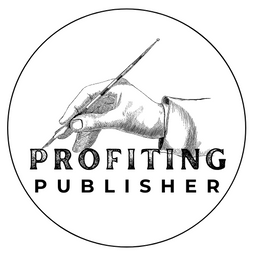Let's be real.
Most writers fail to succeed at writing online. They go from consuming, to creating, and right back to consuming. It's a vicious, unrewarding cycle.
Here's the bottom line: You must know how to write.
Luckily, I've written a 3,000-word guide helping aspiring digital writers (like you) master the craft. After reading that, you're ready to build your brand. It's time to unleash that hidden potential with the world's loudest microphone.
Social Media
And let's face it, digital writing isn't what it used to be.
In the past, you needed a blog. You were forced to post into oblivion. Straight into the void. Hearing crickets for countless:
→ Days
→ Weeks
→ Months
Dare I say... Years?
Well not anymore. Now, you can go to the audience with your digital writing dexterity. And I'm about to share exactly how.
Buckle up.
🥇 First Things First
Your brand-building efforts fall into 3 main buckets:
- Attention
- Retention
- Monetization
They must be filled in the order you see them presented.
If not? It's all out of whack, and chaos will ensue. I'm warning you now, do this out of order and you'll stunt your success in a major way.
No one wants that.
So let's get learning...
🪣 Bucket 1 → Attention
I'll admit it.
Without attention, there is no brand. You need eyes on your work. It's the only way to be seen in a world full of trends and TikToks.
This brings us to the bad news: As text-based creators, we writers have it harder.
With that said, it's never been easier to succeed in the digital landscape. That's the good news. But you must listen closely.
The best way to gain attention is through platforms that attract readers.
Here are my 3 favorites:
- Medium
Twitter and LinkedIn are best for short-form writers, and Medium is best for you long-form junkies out there. I write on all three and suggest you do the same.
They'll each teach you something valuable on your digital writing journey.
🪣 Bucket 2 → Retention
Welcome to level two.
Once you've attracted attention from the masses, it's time to divert it. And if I'm being honest? There's only so much punch we can pack with social media.
A Tweet only scratches the surface.
A LinkedIn post only goes so far.
A Medium article, a bit better.
The key here is this: Long-form resonates.
But not just any long form. Going with the Medium argument, if a reader finds your article (and loves it) they clap or comment, without ever returning.
You don't "own" that reader.
But what you can own, is an email list.
I'm talking about a weekly newsletter...
With a weekly newsletter, you can take your most dedicated fans, and create a whole new level of trust between you both.
On top of the resonating nature of long-form content, you can be:
- More personal
- More educational
- More interconnected
It truly is a beautiful thing. And not only because you can make a greater impact on them, but you can make a greater impact on yourself, through monetization.
That's what's next.
🪣 Bucket 3 → Monetization
Here's the best part about monetizing a weekly newsletter.
You can keep it free for the reader and still make boatloads of money. There are several different ways, but I'll quickly cover the 2 most popular:
- Sponsorships
- Digital assets
A large list of emails—that is hungry for niche content—can be wildly valuable not only to you but to companies and businesses who'd benefit from marketing to it.
Let's say you write about graphic design. A company like Canva of Figma would love to get exposure from that list, wouldn't you say?
That's your edge.
Leveraging sponsorships on your (free) weekly newsletter goes a long way. It's scalable revenue, depending on the growth of your list.
The other option is digital asset promotion.
You can market your own products and services to the dedicated audience you've so passionately cultivated. After all, they've gained trust in you.
Which means they're more willing to open their wallet.
✍🏼 Tactics, Techniques, and Strategies
Think about this for a second.
Without the bucket of attention, there can be no retention or monetization. And monetization is what you're most likely after the long run. So, this guide will focus on tactics, techniques, and strategies for building attention through social media.
That will then give you the ability to retain and monetize your audience.
Shall we get started?
🪜 Climb the Profile Ladder
Let's get one thing straight.
A social media profile must be treated like a landing page. It's where all potential followers come before making their decision. And you're not selling a product.
You're selling yourself.
So let's perfect your profile, step-by-step.
Step 1 → The Profile Picture
There's a lot of debate about what people see first.
Your bio.
Your banner.
Your profile pic.
None of it matters. Who cares about the order anyway, am I right?
What matters is this:
Quality.
Let's talk about the elephant in the room. Your face. Some people have no issue posting their pictures online, while others fear for their lives at the thought of it.
You don't have to post your picture.
But if you're going to, make sure it's a clear and quality image. If you happen to be against it, make sure it supports your topic, category, or niche.
That's all there is to say, so I'll leave it at that...
Step 2 → The Bio
Your bio must answer 3 questions:
- What do I do?
- What am I doing?
- What will people get?
It's very simple. We'll use my Twitter account as an example:
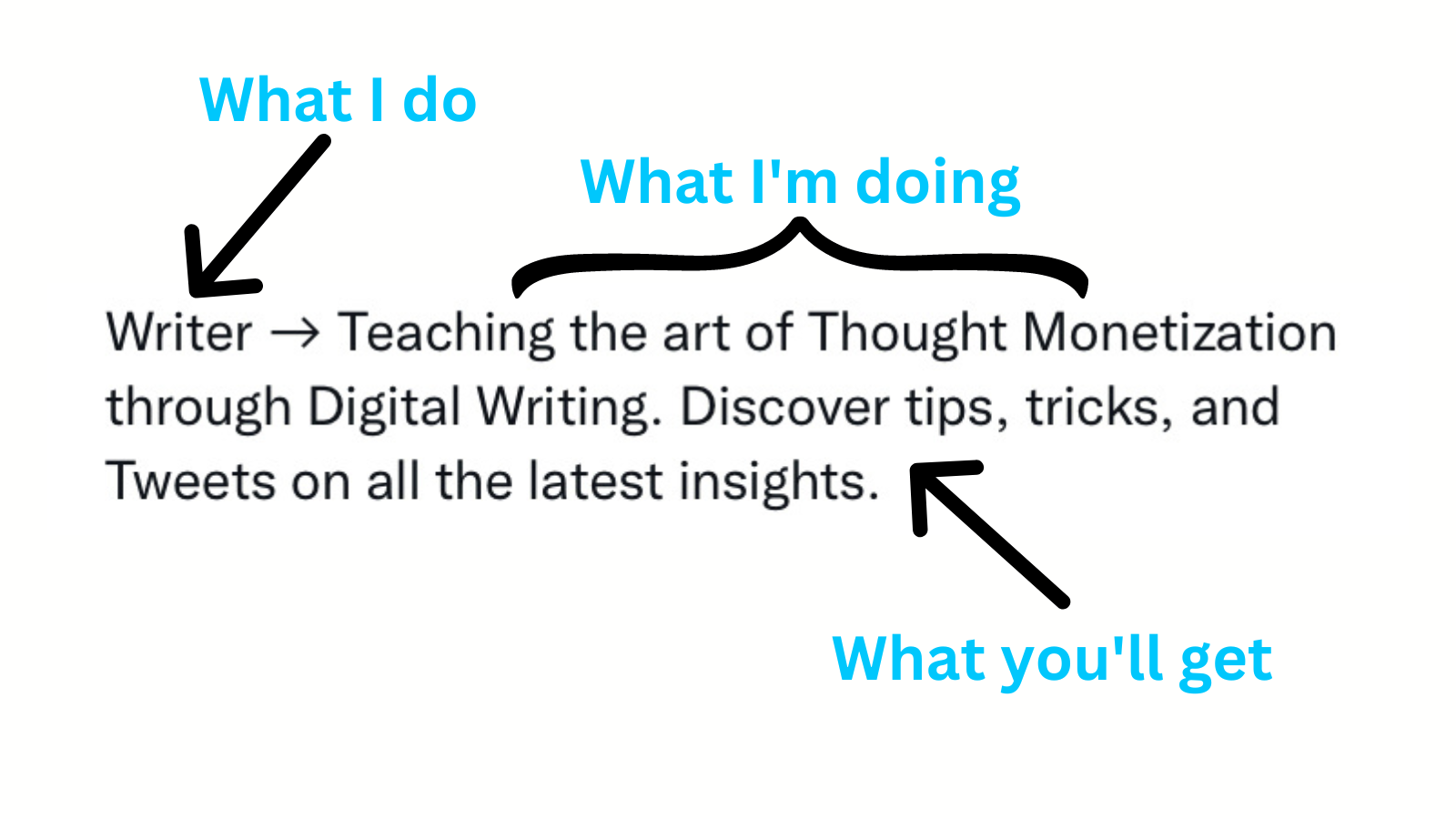
It's best to keep this simple.
I see far too many bios that grossly overcomplicate it. They're trying to impress people. And they come off as total try-hards.
No one likes a try-hard.
Here's another example of a great bio (and overall profile).
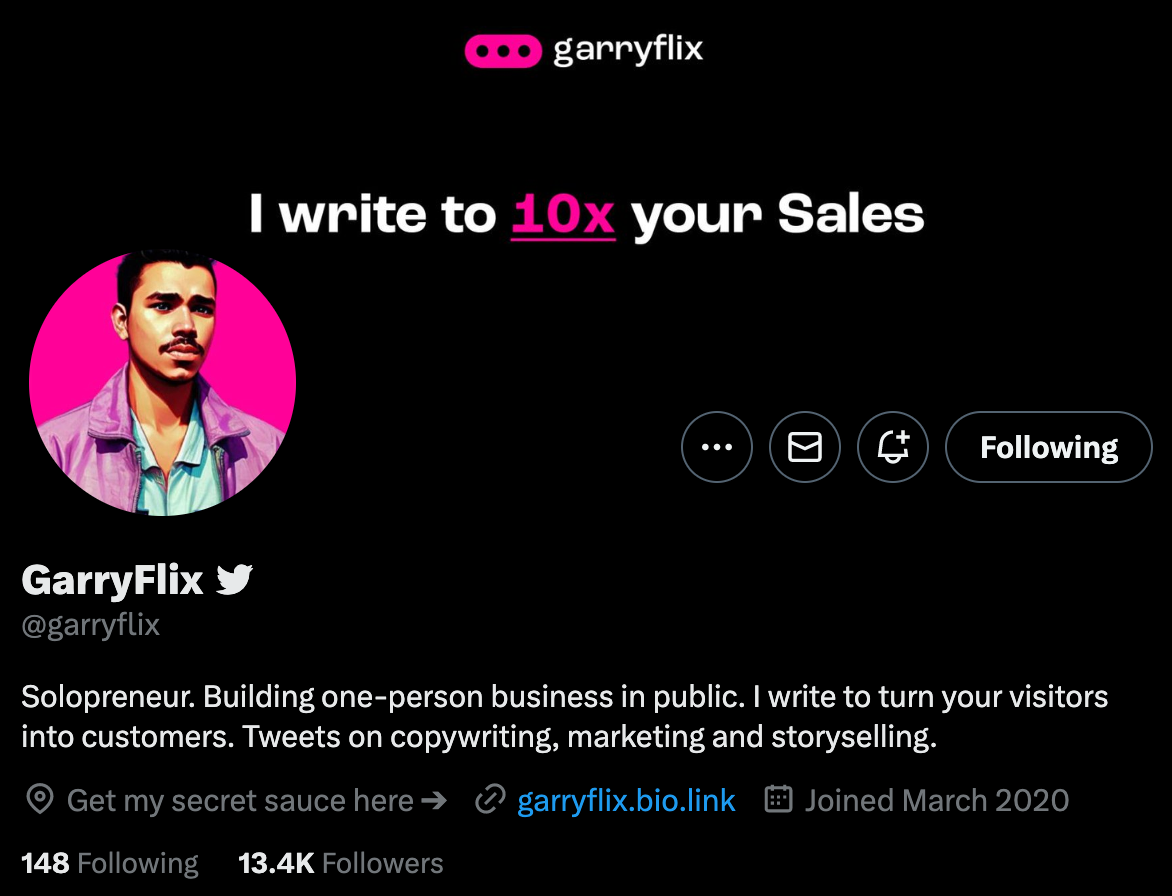
Garry sits in alignment with everything I'm breaking down, so make sure to pay attention. Once you nail your bio and profile picture, it's time to hunker down on the header.
Step 3 → The Header
I'll start by saying this.
Over time, I've continuously simplified my banner image. The point of a good header is to support the profile, not take attention away from it. If there's too much mental stimulation, it might hurt you rather than help.
I think it's good practice to reinforce your category.
Show the people what you wanna be known for. Shove your niche down their eyeballs. It may sound harsh, but I don't want you to mess this up.
Here's how I do it on LinkedIn.

See the simplicity?
I try to keep everything "on brand." You see my self-claimed category at a glance (Thought Monetization). Notice the colors, everything fits like a glove.
Wouldn't you say?
Let your banner support your profile. Don't let it become the thief of attention.
💯 The First 1,000
People don't ever shut up about this.
I know you've been beaten over the head with it, but attracting an initial group of followers is vital to your social media success. With that said, you shouldn't get caught up in the specifics of that number.
You won't notice much of a difference between 800 and 1,000.
What's more important, is that you have a decent pool of people to validate your ideas. That's all we really need because then, it's much easier to double down on what's working.
Nearly 14,000 people read this thread I wrote on the different ways to find more followers. Open it in a new tab for later (there's important stuff coming).
Last week, my tiny Twitter account got 50% bigger.
— Joseph Seifert 🎯 (@Joseph__Seifert) October 20, 2022
That’s 100 followers in 7 days.
And it’s climbing quick.
Here’s the 6-sided strategy I’m currently using:
😵💫 Create a Category of 1
Forget about niche.
Eliminate that word from your vocabulary. In my opinion, most of the success I've experienced came from creating a category of 1. It's almost like a monopoly.
You have zero competition
You have 100% control
You have conviction
It's a win-win-win.
Social media is all about standing out. Starring in the spotlight. We're not here to take part, we're here to take over.
So why would you "pick a niche?"
That might be the dumbest advice I've ever heard...
I hate to be harsh (I don't, I actually love it), but let's be honest. If you're gonna talk about how to make money online, you're grouping yourself in with just about every other average Joe doing the exact same thing.
Here's what I did.
When I started on social media, I thought about it for a few seconds. I said to myself, what am I really doing here? And then it hit me like a freight train.
I'm monetizing my thoughts...
Alas, "Thought Monetization" was born.
My claim to fame. The name of my game. You pickin' up what I'm puttin' down?
You gotta come up with something unique.
Something that people will actually remember you for. And then you can blast it across the internet using your:
- Profile
- Content
- Comments
Literally, everything you do, ask yourself:
"Does this align with my monopoly? My category of 1?"
If so, press publish. If not, take it to the trash.
Moving on...
👑 Authority Content
"Do this. Do that. Here's how you should do ABC to get XYZ."
Oh, give me a break.
Do NOT be this person. Unless your name is Stephen King, I'd really appreciate it if you didn't try to tell me how to write a hit horror story.
I'm sure you've seen this type of content before.
And most likely, it's coming from someone who's got no idea what they're talking about with a llama wearing sunglasses as their profile picture.
I'll be completely honest with you.
I've fallen into this trap as well. At the beginning of my digital writing journey, I felt that I needed to flex my knowledge. I was trying to tell people what I thought they wanted to hear, but it's nonsense.
And I'll tell you why.
Do you like being told what to do?
I bet not. No one does. So when the shades-wearing llama is trying to tell you how to make $10k MRR on Twitter, it just seems a little... I don't know, ridiculous.
But there is a way you can flip this around and still flex your intellect.
If you're so knowledgeable about your "niche", then why aren't you telling me about your experience? About your hardships, your lessons, and all your top tips?
This is the key to authority content: Experience.
Instead of saying, "Do X to get Y", try telling them what you've done. Give them your experience. Prove it to them.
The hook I used in the thread from earlier gives a good example.
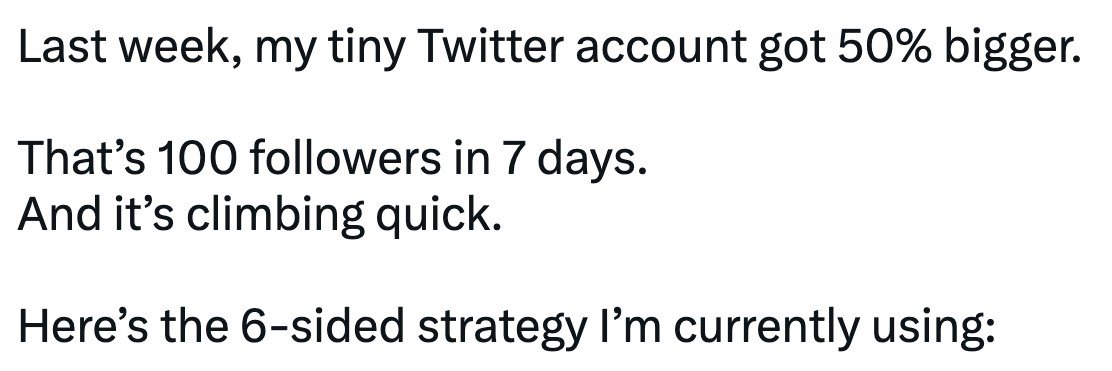
Can you guess why this did well? I told you what I achieved right off the bat:
"Last week, my Twitter account got 50% bigger."
Then I threw in a couple cool stats to really drive the point home. Just to stress the benefits, in case the "50% bigger" didn't catch your eye.
Next, comes the value proposition:
"Here's the 6-sided strategy I'm currently using."
Notice I didn't just come right out and say, "Here's everything you need to know about gaining 100 followers in a week."
The way you frame your content matters. No one likes a know-it-all, and no one wants to be told what to do.
So start helping people with your authority (your experience).
🗣 Finding Your Voice
Alright, listen up.
If I had to tell someone how to "find their voice" on social media, I'd tell 'em exactly the way I'm telling you right now. I wouldn't try to be someone I'm not and I wouldn't try to model the famous dude in the corner. I'd do one thing.
Be myself.
It ain't rocket science. Just as your category of 1 needs to be unique, so do you.
And it's a good thing too. Because there's no one on this planet that speaks and thinks exactly as you do. The digital space is crowded, it's competitive.
Dare I say... Saturated?
*Gasp*
Fear not. The way you communicate online says a lot about you. And if you do it right—like the way I'm telling you right now—you shouldn't have an issue.
Make sure to mention your:
☑︎ Fears
☑︎ Desires
☑︎ Passions
☑︎ Aspirations
☑︎ Philosophies
And mention them with energy. Passion can cover more distance in the digital world than you might think. The audience knows when you're not into it, trust me.
The key to magnetic writing is this:
Find your voice (your real one), and don't stop talking...
🙋🏻 Speak to One Person
Here's how I see the writer-reader relationship:
It's just the two of us. You and me. No audience, no mass messaging, no noise from the outside world. Just us.
Doesn't that sound nice?
It makes you (the reader) feel included. Almost as if I'm writing this post specifically for you. And of course, I am.
The cool thing about digital leverage (and social media) is that we can have this conversation an unlimited amount of times, with an unlimited amount of "you's."
When you're speaking in the social landscape, try not to address the audience as:
- My friends
- You guys
- You all
- Etc.
And if I'm being quite honest, try not the address "them" at all. Because it's just you and me here, remember? Just writer and reader.
Two people engaging in telepathy.
That's writing...
♻️ Content Repurposing
Did you know you can recycle your content like the plastic in your pantry?
If you're serious about building a brand as a digital writer, you're most likely posting on more than one platform. And when you think about publishing 1,000 organic Tweets per year, while keeping up with LinkedIn, and writing a weekly newsletter, it's super-duper-scary.
But not when you have a solid repurposing strategy.
So here's the deal.
Each piece of content starts with an idea. Don't think of it as a Tweet, a LinkedIn post, or a Medium story. It's JUST an idea.
Now watch this.
Step 1 | Choose an idea
Step 2 | Package the idea as a Tweet
Step 3 | Expand on the Tweet as a LinkedIn post
Very good, repeat 5 times.
Step 4 | Wait for the feedback and pick the most popular post
Step 5 | Turn the idea into a Twitter thread and LinkedIn carousel
You just created several pieces of content from a single idea.
BONUS: Write that thread as your newsletter for the week.
See how this (almost) never ends?
You can create thousands of posts from just a few concepts. As you practice, you'll improve. And this is just the beginning.
If there's one area I suggest you study, it's this.
Platform Specificity.
The reality is, we can't just go copy & pasting everything.
Well, you could, but it's not as effective as tactically packaging your content for certain platforms. The good news is, the hard work is over. You already wrote it!
Now, we just have to modify.
Take this example of a post I repurposed from Twitter to Linkedin:
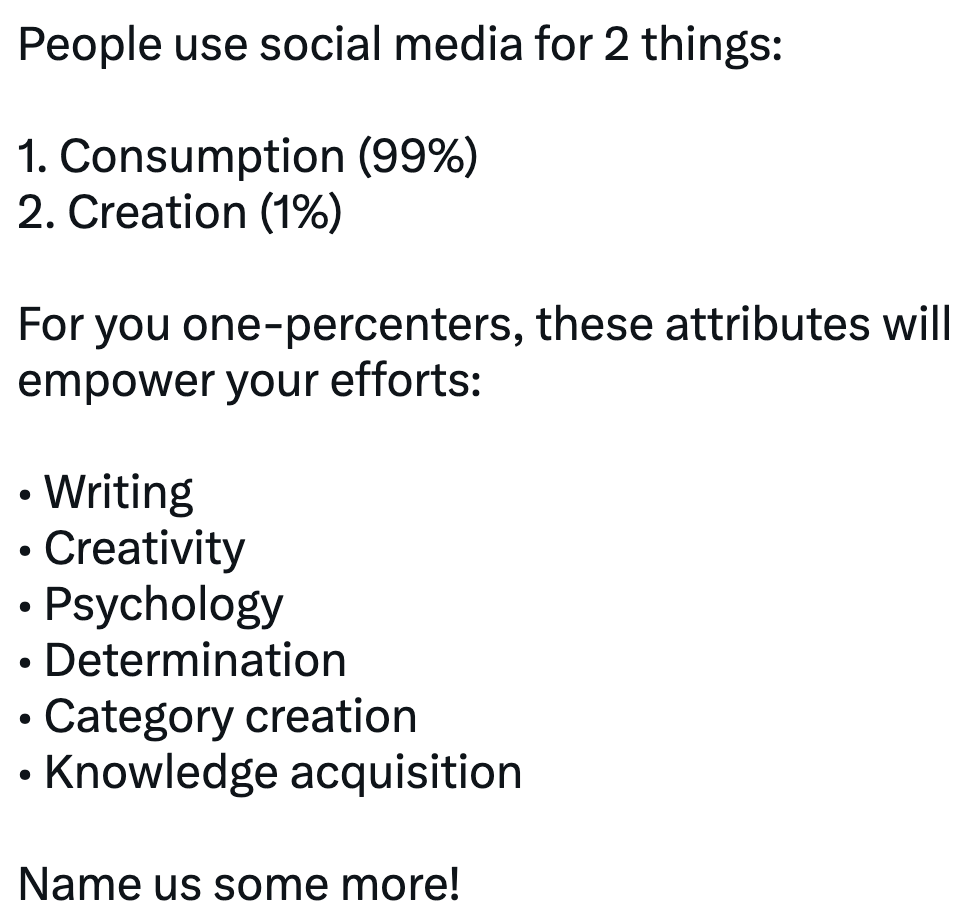
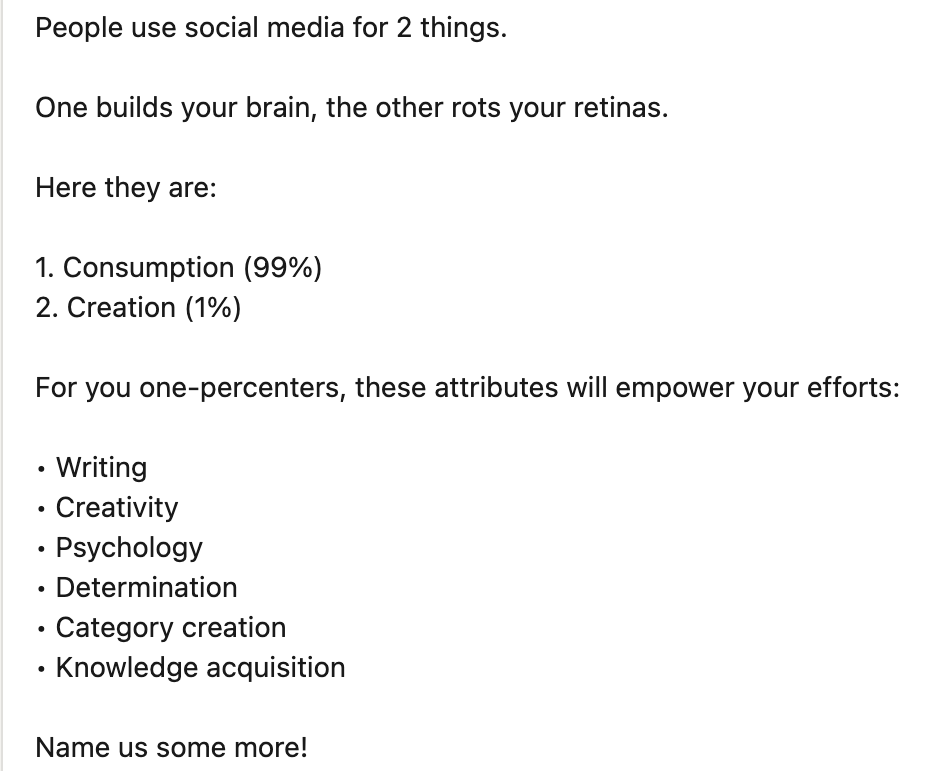
Left = Twitter, Right = LinkedIn
You see, these posts are quite similar.
In fact, most of it actually is copied and pasted. But there's one massive distinction between them. The LinkedIn post has been adjusted for "above the fold" content.
On LinkedIn, the user will see 5 lines of your post before they're prompted to click "see more." This matters because if your "above that fold" content isn't enticing, they'll never see the rest of your work.
It's almost like writing a hook or headline.
If they don't click, they don't read. So make sure you give your reader a reason to click. It's imperative.
As you learn the ins and outs of each platform, you'll know exactly what to do.
🔗 Deplatforming
This is where we take control.
Deplatforming is a skill. Without developing it, you'll have a tough time gaining ownership of your audience and eventually monetizing them. Don't you remember our 3 buckets?
Here's a reminder:
- Attention
- Retention
- Monetization
Deplatforming is essential for the 2nd & 3rd.
My favorite way to do it really isn't rocket science. When I'm fortunate enough to have a well-performing social media post on my hands, I plug my digital assets (or weekly newsletter) beneath the post. It's simple and effective.
You don't wanna be too gung-ho about this.
Otherwise, the audience might get sick of hearing about it. That will do the opposite of driving them to your exclusive content. It'll push them away.
To make this easy, I use a content scheduler.
With Hypefury, I can use something called an auto-plug which links my call-to-action. That way, I don't forget and miss out on a few extra newsletter subscribers.
Here's a great issue from The Profiting Publisher for more deplatforming ideas.

🧠 Final Thoughts
Building a brand is an art.
I suppose it could even be considered a science. And after a year of writing on the internet, I've learned a lot.
Here are some of my takeaways that may help you:
- Don't obsess over analytics, utilize them well
- Not every piece of content will be a hit
- Practice your skills relentlessly
- Show your emotions
- Stay vulnerable
- Be patient
- Write
There are many more. Most, you will find on your own. That's a good thing.
Everyone's journey is different, and comparison is the death of your talent. Don't pay attention to what others are doing, just put one foot in front of the other.
I believe in you.
Good luck, and happy writing!


